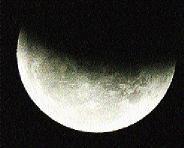
A shadow is cast on the Moon as it exits the Earth's shadow during a lunar eclipse over the sky of Kingston in March last year. The phenomenon was observed worldwide but Europe, Africa and the Middle East got the best view. - Junior Dowie/Staff Photographer
This afternoon at 8:43, Jamaicans and North Americans alike will be able to feast their eyes on a total lunar eclipse.
This event will not be seen again until 2010.According to the website astronomy.com, a total lunar eclipse occurs when the Moon, in orbit around Earth, passes fully into the Earth's shadow.During the eclipse, the Moon will burst into a spectacular array of colours. It will appear to be different shades of red with occasional flashes of blue or green across the surface. This is because sunlight passing through Earth's atmosphere becomes scattered and reddened. It is this dim glow that will fill Earth's shadow and light the eclipsed Moon.During the eclipse, the Moon's northern edge will also appear darker than its southern side. This disparity will occur because the Moon's northern limb will lie closer to the centre of Earth's shadow.The eclipse will last for a total 51 minutes. During the first half, as the sky will become progressively darker, the background stars of the constellation Leo the Lion will appear. The constellation's brightest star, Regulus, appears three degrees above the Moon.People will also be able to see with the naked eye the planet Saturn four degrees to the Moon's lower left. The eclipse is a great opportunity to notice how the Moon moves through the sky, astronomers say. As the eclipse begins, the Moon lies 4.4 degrees from Saturn. When the event ends, the gap measures only 3.5 degrees.After the eclipse, the Moon will take another 78 minutes to leave Earth's shadow.

